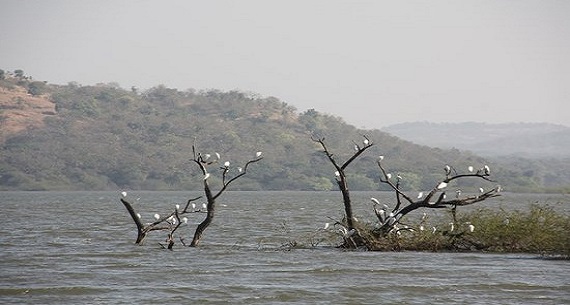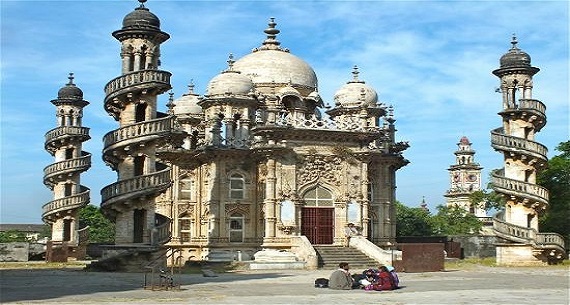
Sasan Gir
The Gir National Park is very popular among the tourists and is a famous sightseeing pull of Sasan-Gir. The national park came into existence in the year 1977 . Sasan -Gir or the Gir Forest National Park is located in the Indian state of Gujarat. Spread across an area of 1412 square km, this sanctuary was established in 1965 to protect the dwindling population of lions. Today, it is the only place where Asiatic Lions can be found, and that makes it one of Asia’s most important protected areas.

Sasan-Gir National Park
The Sasan-Gir National Park is the most popular sightseeing attraction of Sasan-Gir. This park was established in 1965 and it spreads over an area of 1412 sq. km. It is most popularly known for its population of Asiatic lions and considered as the safest protection areas for these Lions. The eco-system and diverse species of flora and fauna in this park are preserved by the combined efforts of Government Forest Department, NGOs and several wildlife activists. The lion breeding programme carried at this park has successfully bred around 180 lions since its inception. Amongst the floral species of this park, there are 400 plants while the fauna species are 2375. These fauna species are divided as 38 of mammals, 300 of birds, 37 of reptiles and 2000 of insects. Popular carnivores found in the place are Asiatic lions, Indian leopards, jungle cats, striped hyenas, golden jackals and many more.
- Entry:Paid
- Not Allowed:Pets
- Timings :Opening & Closing: Summer: 6.00 AM - 6.30 PM , Winter: 6.00 AM - 6.30 PM

Somnath Temple
The Somnath Temple is situated at 46 km from Sasan-Gir. It is one of the most popular and ancient Hindu religious temple of India. The temple is said to be one of the richest temples of ancient India but it lost its charm after it was looted several times by the forces of Mahmud of Ghazni in 10th century AD. It was earlier known as ‘Prabhas Patan’ and is one of the 12 important Hindu shrines of Lord Shiva. Its fair held at ‘Karthik Purnima’ of Hindu calendar is also quite an attraction amongst tourists. Nearby attractions of Somnath Temple includes Somnath Beach, Somnath Museum, Junagadh Gate, Bhaika Teertha, Jama Masjid, Ahilyabai Temple, Bhidiyo Pagoda, Gir National Park, Chorwad Beach, Mai Puri and Port of Veraval.
- Not Allowed:Pets
- Timings : Opening & Closing: Monday - Friday: 7.00 AM - 8.00 PM , Saturday: 7.00 AM - 8.00 PM , Sunday: 7.00 AM - 8.00 PM , Public Holidays: 7.00 AM - 8.00 PM

Junagadh Zoo ( Sakkar Baug )
The Junagadh Zoo is situated in the Junagadh district and is mainly known for its Gir lions. This zoo was built by Nawab in 1863 with the motive of saving these lions from extinction. Now, this zoo has turned into an established safari park. This park will somehow provide you a small glimpse of the Sasan Gir Wildlife Sanctuary through its surroundings as well as through its collection of wildlife. Its main species of fauna comprises lions, leopards and tigers. It also houses a well maintained museum that has on display several paintings, archaeological findings and manuscripts along with a unique history section.
- Entry:Paid
- Not Allowed:Pets
- Timings - Opening & Closing: Monday - Friday: 9.00 AM - 6.00 PM , Saturday: 9.00 AM - 6.00 PM , Sunday: 9.00 AM - 6.00 PM , Public Holidays: 9.00 AM - 6.00 PM

Uperkot Fort
The Uperkot Fort was built by Chandragupta Maurya in 319 BC and has been extended by several emperors, since then. It also has been besieged 16 times and it was also abandoned during the period of 7th to 10th century until it was rediscovered out of an overgrown jungle. At the entrance of this fort, there are three gates and the walls of this fort are 20 m high. The premises of this fort also comprise of a mosque, which has been made out of demolished Hindu temples in the place. The nearby attractions of Uperkot Fort include Tomb of Nuri Shah, two baolis and several Buddhist caves.
- Timings - Opening & Closing: Monday - Friday: 6.30 AM - 6.30 PM , Saturday: 6.30 AM - 6.30 PM , Sunday: 6.30 AM - 6.30 PM , Public Holidays: 6.30 AM - 6.30 PM

Kamleshwar Dam, Sasan gir
The Kamleshwar Dam is situated within the Sasan-Gir National Park, in its very centre. This dam is built over one of the seven rivers that drain in the area of Gir Sanctuary. These rivers include Shingoda, Raval, Godavari, Macchundri, Hiran, Datardi and Saraswati. Kamleshwar Dam is built over Hiran River. It is also referred to as the life line of Gir. It is the breeding site of marsh crocodiles of Gir along with being the halt point of many species of birds.

Durbar Hall Museum
The Durbar Hall Museum is situated near the Diwan Chowk in the old Palace and preserves some of the rarest items of the erstwhile Nawabs. These items include weapons, armour, chandeliers, howdahs and palanquins. A collection of thrones, silver articles, paintings, costumes and tapestries is also at display in this museum. The carpet woven in Junagadh's jail is also present here. Pictures of the Nawabs in the form of a gallery of their royal portraits are also a part of this museum.
- Entry: Paid
- Not Allowed: Pets
- Timings - Opening & Closing: Monday - Friday: 9.00 AM - 6.00 PM , Saturday: 9.00 AM - 6.00 PM , Sunday: 9.00 AM - 6.00 PM , Public Holidays: 9.00 AM - 6.00 PM

Mahabat Maqbara,Junagarh
The Mahabat Maqbara is a grand mausoleum of Nawab, built in 1892 in an Indo-Islamic architectural style. This mausoleum has been testified as the best structure made in this architectural style amongst other such structures in India. The doors and minarets of this mausoleum are made out of silver and surrounded by spiralling stairways.
- Not Allowed: Pets

Gondal
Gondal only 130 km from sasan Gir .The various tourist attractions in Gondal are the Riverside Palace, Orchard Palace, Royal Garages and Naulakha Palace Riverside palace is set in lawns and gardens beside the river Gondal. The Orchard Palace is located in a huge complex of fruit orchards, lawns and gardens. This palace is a wing of the Huzoor Palace, where the ruling family of Gondal entertained guests. The 'room of miniatures' is a splendid sitting room with a collection of miniature paintings, brass and antique furniture. The Royal Garages have an extensive collection of vintage and classic cars from 1910 to 1955, Most of these cars are restored and some bear the original Gondal State number plates. Naulakha Darbargadh Palace was built during the 17th century. This palace is one of the oldest and the most beautiful palace in Gondal. This palace is situated on the banks of the river on a grand masonry base, rising about 30 meter above the river bed. This palace was built in about nine lakhs and thus named so. The palace is approached by the high gateway with the clock tower from the town side. The private palace museum displays artifacts and gifts received by Maharaja Bhagwat Sinhji as a ruler of Gondal, on his 50th birthday and various other relics.

Diu
Diu is only 95 km away from Sasan Gir . Located near the port of Veraval, Diu is a small island which was earlier a Portuguese colony, and is now guarded by beaches all around.Diu takes up most popularity given the ample number of beaches, along Gujarat's southern coast such as the Nagoa beach, but has a lot more to offer too. The Diu Fort, a primary imprint of the Portuguese on the area's heritage and architecture makes up a popular tourist attraction. Another interesting place is the Vanakbara, a small fishing village whose charm has tints of colourful fishing boats and humming of day to day activity. This perfect add-on to a visit to Gujarat will complete your experience with interesting museums such as the Sea Shell Museum, temples and churches.

Girnar Mountain
The Girnar Mountain, located 5 kms east of Junagadh district are another famous attraction. It is situated an altitude of 1100 m high and it comprises of Jain Temples that are to be found at the hilltop. The Jain Temples were constructed between 1128 and 1500.
Animals: The entire forest area of the Gir National Park is dry and deciduous which provides best habitat for Asiatic Lions. As per the new statics of 2015, the entire Saurashtra Region is inhabited by 523 Lions and more than 300 Leopards. Apart from these two animals the park is a home to two different species of Deer. The Sambar is counted largest Indian Deer. The Gir forest is also known for the Chowsingha – the world’s only four horned antelope. The Jackal, striped Hyena and India Fox are some of the smaller carnivores found in Gir Forest.